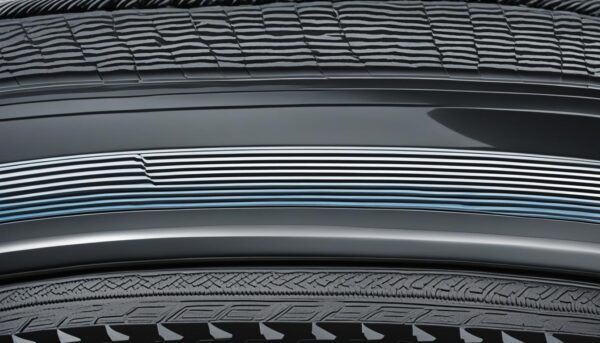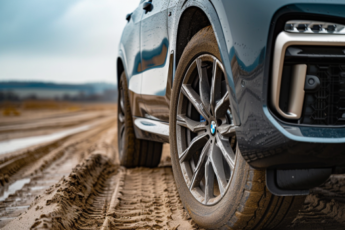Last Updated on 1 week
Understanding Legal Requirements for Winter Tires
In some regions of the U.S., where extreme winter weather is typical, local legislation has introduced winter tire laws and travel restrictions to improve road safety during snowy and icy conditions. These laws involve understanding tire classifications and certifications to distinguish between all-season and dedicated winter tires.
The terms M+S (Mud and Snow) and winter tires often cause confusion among motorists and law enforcers alike, as tire jargon can be convoluted with classifications like “all-season tires,” “all-weather tires,” and “summer tires” offering no uniformity in performance expectations. The M+S marking, dating back to the 1970s, indicates tires with improved traction in mud and snow, while today’s “Three Peak Mountain Snowflake” symbol signifies a tire that has passed more rigorous winter-specific traction tests. Knowing the difference and the appropriate laws in your locale can significantly affect safety and compliance.
Key Takeaways
- M+S tires and winter tires have different classifications and certifications.
- Understanding tire classifications is essential for compliance with local winter tire laws.
- The M+S marking is an older classification indicating improved traction in mud and snow.
- The Three Peak Mountain Snowflake symbol is a newer, more rigorous certification for winter-specific traction.
- Proper tire selection is critical for car safety during winter driving conditions.
- Drivers should be informed about winter tire legislation in their region to ensure compliance and safety.
- Choosing the correct winter tire can significantly impact vehicle performance and driver safety.
Uncovering the Myths: M+S Tires Explained
Often seen on all-season tires, M+S tires are marked as suitable for varied conditions, including light snow and mud. However, they have evolved significantly from their original 1970s design, which required a block tread pattern for the M+S designation. Today’s M+S tires are found to offer essential snow traction. Still, they may fall short of typical winter conditions, and their certification standards are lower than expected for rigorous winter driving.
Buyer Beware: M+S tires are not always the best choice for harsh winter conditions.
Organizations like the Rubber Manufacturers Association (RMA) and the Department of Transportation (DOT) offer additional certification, indicated by the “Three Peak Mountain Snowflake” symbol. This certification process ensures consumers an improved standard of winter tire traction, helping them make more informed decisions when selecting tires that advertise all-season capabilities and comply with winter driving regulations.
- M+S Tires: Suitable for varied conditions, including light snow and mud.
- Three Peak Mountain Snowflake: Tires pass more rigorous winter-specific traction tests.
Considering the differences between M+S tires and those with the Three Peak Mountain Snowflake symbol is essential when shopping for tires that will perform optimally during winter. Please consult the table below to compare their characteristics and performance in winter conditions.
| Feature | M+S Tires | Three Peak Mountain Snowflake Tires |
|---|---|---|
| Tread Pattern | Block tread pattern, suitable for light snow and mud | Deeper grooves and more biting edges for improved snow and ice traction |
| Certification Standards | Lower standards, mainly ideal for light winter conditions | Rigorous standards, offering superior performance in harsh winter conditions |
| Tire Traction | Essential snow traction might not be enough for heavy snowfall | Optimal traction on snow-covered and icy roads |
| Winter Driving Regulations Compliance | May not fulfill requirements in areas with strict winter tire laws | Meets legal requirements where winter tires are mandated |
In conclusion, while M+S tires can provide better traction than summer tires in some winter conditions, they might not fulfill the demands of more severe winter environments. Understanding the certification standards and differences between M+S tires and Three Peak Mountain Snowflake tires is essential to comply with winter driving regulations and ensure safety on snowy and icy roads.
The Importance of Tire Certifications for Winter Driving
Tire certifications ensure safe and legal driving in cold weather conditions. Knowledge of various tire markings helps drivers make informed decisions when selecting appropriate vehicle tires while complying with local winter tire laws. This section will explore the “M+S” marking and the Three Peak Mountain Snowflake (3PMSF) symbol to understand their significance and impact on winter driving safety.
Understanding the “M+S” Marking
The “M+S” marking on a tire signifies higher traction in mud and snow than older ribbed tread designs. To be qualified as an M+S tire, a tire must possess a specific tread pattern style and demonstrate increased traction capabilities. Though today’s performance criteria for this classification are considered minimal, the M+S marking is a primary indicator for consumers and law enforcement to gauge a tire’s suitability for winter conditions.
The Significance of the Three Peak Mountain Snowflake Symbol
The Three Peak Mountain Snowflake (3PMSF) symbol on a tire sidewall indicates the tire has undergone rigorous winter traction tests. It is certified to offer high-performance levels in snowy conditions. Introduced in the late 1990s to distinguish actual winter tires from standard all-season tires, the 3PMSF symbol shows that a tire meets current industry standards for snow traction performance. In certain regions, winter tires sporting this symbol are legally required to guarantee vehicles are adequately equipped for navigating snow-covered and icy roads.
“The 3PMSF symbol on a tire sidewall indicates that the tire has been specifically tested for winter traction and performance, providing drivers with the assurance they need for safe and legal winter driving.”
By understanding the differences between the M+S marking and the 3PMSF symbol, drivers can make informed decisions when selecting tires that offer optimal performance and safety in winter conditions. Additionally, knowledge of these certifications ensures compliance with legal winter tire requirements and promotes safer roads for all during the colder months.
Why Tire Classification Matters For Winter Safety
Tire classification is more than just a marketing distinction; it’s an essential safety consideration for driving in winter conditions. Correctly classified tires ensure that drivers equip their vehicles with tires that offer genuine performance in the challenging and potentially hazardous conditions typical of winter months. The confusion stemming from varied designations by different manufacturers can lead to unsafe tire choices and non-compliance with local winter tire laws.
Understanding tire classifications and selecting tires certified for winter driving (such as those with the Three Peak Mountain Snowflake symbol) is vital for enhanced traction, control, and safety on wintry roads.
- Tire classification: Essential for making informed decisions about suitable tires for different conditions and complying with winter tire safety regulations.
- Winter tire safety regulations: Guidelines implemented to ensure drivers use appropriate tires for winter driving conditions, promoting increased safety on wintry roads.
- Mandatory winter tire laws: Legal requirements imposed in certain locales necessitating the use of winter tires during specific months or under particular conditions.
Knowing the key differences between various tire classifications allows more informed decision-making when purchasing tires. This knowledge also aids in complying with any mandatory winter tire laws that may be enforced in your region.
Table: Comparison of Key Tire Classifications and Certifications:
| Tire Classification | Main Features | Pros | Cons |
|---|---|---|---|
| M+S Tires (Mud and Snow) | Intended for light snow and mud, basic snow traction capabilities | Usually less expensive than winter tires, adequate for mild winter conditions | Not as efficient in extreme winter conditions |
| Winter Tires (with Three Peak Mountain Snowflake symbol) | Engineered for harsh winter conditions, tested for high levels of snow traction | Superior performance in snowy, icy conditions, reduced stopping distances | Potentially more expensive due to specialized design, recommended to swap out during warmer months |
Codifying specific tire classifications allows for more transparent communication between manufacturers, retailers, regulators, and consumers. This clarity promotes safer driving habits, adherence to legal requirements, and improved road safety in extreme weather conditions. Ultimately, thoroughly understanding tire classification is crucial for selecting appropriate tires and following winter tire safety regulations during the colder months.
Digging Into the Details: Tread Design and Rubber Compounds

The intricacies of tread design and rubber compounds greatly influence winter tire performance. In this section, we dive deep into the engineering behind tread patterns and how rubber compounds affect tire performance in cold weather.
The Engineering Behind Tread Patterns
Winter tires feature sophisticated tread patterns that differ significantly from M+S tires. With deep grooves and multiple biting edges, winter tire tread patterns are designed to penetrate snow and ice, providing substantially better handling in severe weather conditions. This contrasts with M+S tires with a less aggressive tread pattern, which may underperform when facing heavy winter weather.
- Winter tire tread patterns have deep grooves to clear snow from the contact patch, ensuring the tire maintains its grip on the road.
- Sharp, biting edges dig into slippery surfaces, enhancing traction in snowy and icy conditions.
- Winter tire treads often feature zigzag sipes, which are small slits that improve traction on ice by creating more edges that can grip the surface.
Tread design is a crucial aspect of winter tire performance, enabling them to provide excellent traction and control even in the harshest winter conditions.
How Rubber Compounds Affect Tire Performance in Cold Weather
Rubber compounds play a pivotal role in tire performance during cold weather. Winter tires have a softer rubber compound that remains flexible even at low temperatures, ensuring a firmer grip on icy roads. In contrast, the rubber compounds in M+S tires are usually better and may not offer the same level of grip in colder weather, which could compromise vehicle control and safety.
| Temperature | Winter Tires | M+S Tires |
|---|---|---|
| Above 45°F (7°C) | The softer compound starts to wear faster. | The firmer compound provides better tread wear and fuel efficiency. |
| Below 45°F (7°C) | A softer compound maintains flexibility and grip. | The firmer compound becomes stiffer, leading to reduced traction. |
Moreover, modern winter tires also include specialized features like siping, which are small slits in the tread that further enhance traction on ice. These sipes create more edges on the track that can grip icy surfaces and offer better directional control when driving.
Winter Tire Regulations Across the United States
Winter tire regulations and requirements can vary significantly from one area to another within the United States, mainly depending on the severity of local winter weather conditions. Some regions mandate the use of winter tires during specific months or under certain weather conditions, and non-compliance can result in fines. Drivers need to acquaint themselves with the local winter tire laws for maximum safety, avoid violations, and ensure that they drive legally. These laws can also affect choices when purchasing tires, as selecting the correct winter-spec tires may be a legal obligation in certain areas.
It is essential for drivers to acquaint themselves with the local winter tire laws, not only for maximum safety but also to avoid violations and ensure that they are driving legally.
To provide a deeper understanding of the critical regional differences, let’s explore the winter tire requirements and regulations in some states across the U.S.:
| State | Winter Tire Regulations |
|---|---|
| California | Chains or snow tires are required when chain control signs are posted in particular areas during winter. Snow tires must have a minimum tread depth of 6/32 inches. |
| Colorado | Winter tires or chains are required on specific routes during the winter season. |
| Michigan | There are no specific winter tire laws, but studded tires are prohibited unless within 10 miles of the state border and in use before entering the state. |
| New York | No specific winter tire laws exist, but studded tires are allowed between November 1 and April 30. |
| Oregon | Chains or traction tires (marked with the 3PMSF symbol) are required when signs are posted in particular areas during winter. |
Considering the varying regulations in different states, it is crucial for motorists to research and understand their local winter driving regulations thoroughly.
- Check the state Department of Transportation (DOT) or local police department websites for current regulations and requirements.
- Follow local news channels and weather forecasts to stay updated on changing road conditions and possible tire law updates.
- Use the winter tire/snow tire requirements indicated by the Three Peak Mountain Snowflake symbol when shopping for new tires, ensuring optimal performance and adherence to local winter driving regulations.
By being informed about the winter tire laws in their region and equipping their vehicles with tires that meet local snow tire requirements, drivers can ensure the safety of all road users and contribute to smoother winter driving experiences.
A Comparative Look: M+S Tires vs. Winter Tires
Performance Differences in Severe Weather Conditions
Winter tires are specifically engineered for extreme winter conditions, offering superior capabilities in deep snow and subzero temperatures compared to M+S tires. While M+S tires might handle light snow adequately, their limitations become evident in harsh winter scenarios where the deeper snow and colder temperatures necessitate a specialized tire choice.
| Tire Type | Stopping Distance (on snow) | Cornering Performance | Performance in Cold Temperatures |
|---|---|---|---|
| Winter Tires | 35% shorter than all-season tires | Superior | Outperforms other tire types even on dry pavement |
| M+S Tires | Longer than winter tires | Inferior | Underperforms compared to winter tires in colder temperatures |
| Summer Tires | 50% longer than winter tires | Least effective in winter conditions | Not recommended for use in winter |
The stopping distances and cornering performance of winter tires on snow are significantly better, with winter tires having about a 35% shorter stopping distance than all-season tires and 50% faster than summer tires. The winter tires outperform other types in colder temperatures, even on dry pavement.
- Winter Tire Safety: Winter tires provide more safety on snowy and icy roads than M+S tires, ensuring a better driving experience during severe weather conditions.
- Severe Weather Tire Performance: Winter tires offer superior performance and traction in colder temperatures and inclement weather.
- M+S Tires vs. Winter Tires: While M+S tires are a reasonable choice for mild winter conditions, they do not offer the same safety and performance as dedicated winter tires in extreme cold and snow.
Understanding the differences between M+S tires vs. winter tires is crucial for drivers who want to enhance their winter tire safety and improve overall performance in severe weather conditions. Choosing the right tire according to your regional climate and local winter tire laws will ensure safer and more enjoyable winter driving experiences.
Navigating Winter Tire Laws and Compliance
Navigating the landscape of winter tire laws and ensuring compliance involves awareness of the various classifications, certifications, and specific regional mandates for tire use during winter months. Drivers should be conscientious about checking for tire markings, such as the M+S symbol or the Three Peaks Mountain Snowflake. Law enforcement officers checking for road compliance often rely on these indicators. Understanding and adhering to these requirements is crucial for legal, safe winter driving and can also influence decisions regarding the purchase of winter-specific or versatile all-season tires.
Winter tire regulations can vary significantly between states and even within some regions. Certain tire classifications or certifications may be mandated in some areas under specific weather conditions or periods. To guide you through these complexities, let’s look at some critical aspects of winter tire compliance:
- Check local and regional legal winter tire requirements.
- Understand tire classifications and certifications (M+S symbol, Three Peak Mountain Snowflake).
- Follow snow tire regulations or recommendations by state or regional authorities.
- Keep up-to-date with changes in laws and requests, as they may change yearly.
| State | Winter Tire Legislation | Applicable Period |
|---|---|---|
| California | Chains or snow tires are required in certain areas during winter months. | November 1 to April 30 |
| Colorado | Winter tires or chains are required on certain mountain highways. | September 1 to May 31 |
| Washington | Traction tires are required during severe winter conditions. | Varies based on conditions |
When considering whether to invest in winter or all-season tires with the M+S symbol or Three Peak Mountain Snowflake certification, evaluating the typical winter conditions experienced in your locale is essential. Complying with legal winter tire requirements ensures optimal car safety and decreases the likelihood of accidents, fines, or other legal repercussions for drivers.
“The best way to stay safe on the road during winter is to be proactive in equipping your vehicle with tires that best suit your driving environment.”
In conclusion, staying up-to-date with winter tire laws and compliance requires a solid understanding of tire markings and the specific regional mandates for tire use during winter. Equipping your vehicle with appropriately certified tires guarantees legal compliance and improves safety, traction, and peace of mind during winter journeys.
What Drivers Need to Know About Winter Tire Legislation

Understanding the specifics of winter tire legislation, cold weather tire laws, and winter tire regulations is essential for drivers to ensure safety and legal compliance. The legislation varies across states and regions and can include mandatory winter tire usage during certain periods or under specific conditions. Drivers need to understand the implications of these laws on their vehicles and driving habits.
One crucial aspect of winter tire legislation can be the recognition of specific tire symbols, such as the “Three Peak Mountain Snowflake” for winter tire verification. This symbol serves as an indicator of a tire’s true winter performance capabilities. Various incentive programs might be in place across regions to encourage the use of winter tires, as they contribute to increased safety and improved driving conditions. Awareness of the legislation and such incentive programs are necessary for drivers operating in regions with harsh winter climates.
Furthermore, the winter tire legislation may impact insurance claims if an accident occurs without proper winter tires equipped on the vehicle. Such conditions reinforce the importance of understanding and adhering to your area’s tire laws, regulations, and requirements.
Knowing the local winter tire legislation and symbols can make a significant difference in both safety and compliance. Having appropriate tires on your vehicle ensures your safety and that of others on the road during harsh winter conditions.
- Be aware of local winter, snow, or studded tires legislation.
- Look for recognized tire symbols, such as the “Three Peak Mountain Snowflake,” to verify the tires’ capabilities.
- Equip your vehicle with the appropriate tires specific to the winter conditions of your area.
- Ensure you meet all requirements and regulations to maintain legal compliance and safe driving.
In conclusion, becoming aware of the winter tire legislation and its impact on driving habits is vital for drivers who operate in regions with severe winter weather conditions. By understanding and adhering to these laws, drivers can ensure their safety and that of others while avoiding fines and insurance issues related to non-compliance.
Buying the Right Tires for Your Winter Climate
Selecting the right tires for a specific winter climate is analogous to choosing the proper footwear for seasonal conditions – a decision that can significantly affect safety and comfort. Tires, like shoes, need to provide dependable traction and stability in the situations they are designed for. Winter tires should be considered for those living in climates with temperatures consistently below 45°F (7°C), where they will perform better than other tires even when ice and snow are absent.
Buyers should consider local weather patterns, the topography of their driving routes, and the specific tire certifications that best match their winter weather driving needs. To help you decide which winter tires are suitable for your climate, consider the following steps:
- Research your region’s average winter temperature and precipitation levels. This will give you a sense of the severity and frequency of snowy and icy conditions you can expect.
- Take note of the roads and terrain you typically drive on during winter. Are they hilly, curvy, or prone to ice accumulation? These factors can influence the type of winter tire best suited for your needs.
- Consult local laws or guidelines for winter tire requirements. Some areas may specify which tire certifications, such as the Three Peak Mountain Snowflake (3PMSF) symbol, are necessary for winter driving legality and safety.
When selecting winter tires, it’s crucial to ensure that they will offer optimal traction and stability for your specific winter climate. To help you in your decision-making process, consider the following key features:
Winter tire tread patterns optimized for snow and ice traction, siping for enhanced grip, and a softer rubber compound that remains flexible in colder temperatures.
Given the various factors that must be considered when buying winter tires, weighing the benefits of specialized winter climate tires against all-weather tire performance is essential. In some cases, all-weather tires may be sufficient for milder winter climates, while dedicated winter tires are necessary in harsher environments.
Choosing which winter tire to buy for your winter climate is an essential safety consideration that warrants careful thought. You can make an informed decision by evaluating local weather patterns, considering your driving habits, and adhering to applicable regulations, ensuring optimal traction and stability on the road during winter.
Conclusion
In summary, M+S and winter tires offer distinct performance levels when driving in various winter weather conditions. M+S tires may be adequate for light snow and slush, but dedicated winter tires are explicitly designed to deliver optimal safety and traction in extreme winter situations. Awareness of these differences and local winter tire laws enables drivers to make informed decisions when purchasing tires, ensuring compliance and safety during the colder months.
As winter landscapes continually evolve across different regions within the United States, drivers must take a proactive approach in equipping their vehicles with tires that best cater to their driving environment. This will help maintain excellent control and safety on the road.
Selecting the right winter tire depends on local weather patterns, topography, and specific tire certifications. Adhering to these winter driving tips will contribute to car safety and provide peace of mind while navigating the roads during the winter season.
FAQ
What are the differences between M+S tires and winter tires?
M+S tires are designed for varied conditions, including mud and light snow, whereas winter tires are specifically engineered to handle extreme winter weather, like heavy snow and subzero temperatures. Winter tires have a different tread design and a softer rubber compound, offering better traction and handling than M+S tires.
What is the significance of the “M+S” marking on a tire?
The “M+S” marking indicates that the tire has a specific tread pattern that provides increased traction in mud and snow compared to traditional ribbed treads. However, the performance criteria for M+S tires are considered minimal and may not be suitable for more extreme winter conditions.
What does the “Three Peak Mountain Snowflake” symbol represent?
The “Three Peak Mountain Snowflake” symbol signifies that the tire has been tested and certified to offer high levels of traction in winter conditions. This symbol differentiates genuine winter tires from standard all-season tires and indicates the tire meets rigorous industry standards for snow traction performance.
How does tire classification impact winter safety?
Tire classification is essential for understanding the expected performance of different tire types in winter driving conditions. Choosing the correct tire classification, such as winter tires certified with the Three Peak Mountain Snowflake symbol, ensures enhanced traction, control, and safety on snowy and icy roads.
What are the differences between winter tire tread patterns and rubber compounds compared to M+S tires?
Winter tires feature sophisticated tread patterns with deep grooves and multiple biting edges to penetrate snow and ice, whereas M+S tires have less aggressive tread patterns. The rubber compounds in winter tires remain flexible even at low temperatures, ensuring a better grip on icy roads than M+S tires, which may have firmer rubber compounds.
How do winter tire regulations vary across the United States?
Winter tire regulations and requirements differ depending on the severity of local winter weather conditions. Some regions mandate the use of winter tires during specific months or under certain weather conditions, with fines for non-compliance. Drivers should familiarize themselves with local winter tire laws to ensure safety and legal compliance.
What should be considered when choosing the right tires for a specific winter climate?
Buyers should consider local weather patterns, the topography of their driving routes, and the specific tire certifications that best match their winter weather driving needs. Winter tires are recommended for climates with temperatures consistently below 45°F (7°C), where they will perform better than other tire types even without ice and snow.










